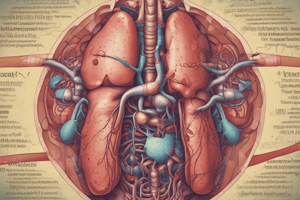Podcast
Questions and Answers
What are the primary functions of the liver in dogs, and how do they relate to overall systemic health?
What are the primary functions of the liver in dogs, and how do they relate to overall systemic health?
The liver performs essential roles, including metabolism (carbohydrates, fats, proteins), detoxification of toxins and drugs, bile production for fat digestion, storage of glycogen and fat-soluble vitamins, and synthesis of clotting factors. These functions are critical for maintaining homeostasis and overall health.
Which major blood vessels supply and drain the canine liver?
Which major blood vessels supply and drain the canine liver?
The liver is supplied by the hepatic artery (oxygenated blood) and the portal vein (nutrient-rich blood from the gastrointestinal tract). The hepatic veins drain blood from the liver into the caudal vena cava.
How does the liver contribute to detoxification and metabolism in dogs?
How does the liver contribute to detoxification and metabolism in dogs?
The liver metabolizes endogenous and exogenous substances through Phase I (oxidation, reduction, hydrolysis) and Phase II (conjugation) reactions, making them water-soluble for excretion. It also processes ammonia into urea and regulates blood glucose by glycogenesis and gluconeogenesis.
What are the most common types of liver disease in dogs, and how do they differ pathophysiologically? (Select all that apply)
What are the most common types of liver disease in dogs, and how do they differ pathophysiologically? (Select all that apply)
How does liver dysfunction lead to secondary systemic effects such as coagulopathy or hepatic encephalopathy?
How does liver dysfunction lead to secondary systemic effects such as coagulopathy or hepatic encephalopathy?
What is the significance of portal hypertension in canine liver disease?
What is the significance of portal hypertension in canine liver disease?
What are the common infectious causes of liver disease in dogs? (Select all that apply)
What are the common infectious causes of liver disease in dogs? (Select all that apply)
How can toxins such as xylitol or aflatoxins lead to liver damage in dogs?
How can toxins such as xylitol or aflatoxins lead to liver damage in dogs?
What role do congenital diseases like portosystemic shunts play in liver pathology?
What role do congenital diseases like portosystemic shunts play in liver pathology?
What are the most common clinical signs of liver disease in dogs, and how do they relate to the liver's role in the body?
What are the most common clinical signs of liver disease in dogs, and how do they relate to the liver's role in the body?
How might a dog with liver disease present differently based on whether the condition is acute or chronic? (Select all that apply)
How might a dog with liver disease present differently based on whether the condition is acute or chronic? (Select all that apply)
Which laboratory tests are most important in diagnosing liver disease in dogs? (Select all that apply)
Which laboratory tests are most important in diagnosing liver disease in dogs? (Select all that apply)
What imaging modalities (e.g., ultrasound, CT) are commonly used to evaluate the liver in dogs, and what findings indicate disease? (Select all that apply)
What imaging modalities (e.g., ultrasound, CT) are commonly used to evaluate the liver in dogs, and what findings indicate disease? (Select all that apply)
What is the significance of liver biopsy in diagnosing specific hepatic diseases in dogs?
What is the significance of liver biopsy in diagnosing specific hepatic diseases in dogs?
What dietary recommendations are typically made for dogs with liver disease, and why? (Select all that apply)
What dietary recommendations are typically made for dogs with liver disease, and why? (Select all that apply)
How are hepatoprotective drugs (e.g., SAMe, silymarin) used in canine liver disease treatment?
How are hepatoprotective drugs (e.g., SAMe, silymarin) used in canine liver disease treatment?
What are the indications for surgical intervention in cases of canine liver disease?
What are the indications for surgical intervention in cases of canine liver disease?
What factors influence the prognosis for dogs with chronic liver disease?
What factors influence the prognosis for dogs with chronic liver disease?
How does the underlying cause of liver disease impact the long-term outcomes in dogs?
How does the underlying cause of liver disease impact the long-term outcomes in dogs?
How can vaccination and preventive care reduce the risk of liver disease in dogs?
How can vaccination and preventive care reduce the risk of liver disease in dogs?
What client education strategies are effective for managing dogs with liver conditions?
What client education strategies are effective for managing dogs with liver conditions?
How can toxins such as acetaminophen or plants (e.g., lilies) lead to liver damage in cats?
How can toxins such as acetaminophen or plants (e.g., lilies) lead to liver damage in cats?
Which laboratory tests are most important in diagnosing liver disease in cats (e.g., ALT, ALP, bile acids)? (Select all that apply)
Which laboratory tests are most important in diagnosing liver disease in cats (e.g., ALT, ALP, bile acids)? (Select all that apply)
Flashcards
Liver function in dogs and cats
Liver function in dogs and cats
The liver plays a critical role in metabolism (proteins, carbohydrates, lipids), detoxification (drugs, toxins), bile production, and immune function (Kupffer cells).
Dog liver disease: Hepatitis
Dog liver disease: Hepatitis
Inflammation of the dog's liver, often caused by infections (e.g., leptospirosis, adenovirus), immune issues or toxins.
Dog liver disease: Portosystemic Shunt (PSS)
Dog liver disease: Portosystemic Shunt (PSS)
Abnormal blood flow bypasses the dog's liver, often having congenital or acquired causes.
Dog liver disease: Hepatic Lipidosis
Dog liver disease: Hepatic Lipidosis
Signup and view all the flashcards
Dog liver disease: Neoplasia
Dog liver disease: Neoplasia
Signup and view all the flashcards
Dog liver disease: Copper-associated Hepatopathy
Dog liver disease: Copper-associated Hepatopathy
Signup and view all the flashcards
Feline liver disease: Hepatic Lipidosis
Feline liver disease: Hepatic Lipidosis
Signup and view all the flashcards
Feline liver disease: Cholangitis
Feline liver disease: Cholangitis
Signup and view all the flashcards
Feline liver disease: Feline Infectious Peritonitis (FIP)
Feline liver disease: Feline Infectious Peritonitis (FIP)
Signup and view all the flashcards
Clinical sign: Jaundice
Clinical sign: Jaundice
Signup and view all the flashcards
Clinical sign: Ascites
Clinical sign: Ascites
Signup and view all the flashcards
Clinical sign: Vomiting
Clinical sign: Vomiting
Signup and view all the flashcards
Clinical sign: Innappetence
Clinical sign: Innappetence
Signup and view all the flashcards
Clinical sign: Lethargy
Clinical sign: Lethargy
Signup and view all the flashcards
Clinical Sign: Hepatic Encephalopathy
Clinical Sign: Hepatic Encephalopathy
Signup and view all the flashcards
Clinical sign: Weight loss
Clinical sign: Weight loss
Signup and view all the flashcards
Clinical sign: Diarrhea
Clinical sign: Diarrhea
Signup and view all the flashcards
Liver's role in Metabolism
Liver's role in Metabolism
Signup and view all the flashcards
Liver's role in Detoxification
Liver's role in Detoxification
Signup and view all the flashcards
Liver's role in Bile Production
Liver's role in Bile Production
Signup and view all the flashcards
Liver's role in Immune Function
Liver's role in Immune Function
Signup and view all the flashcards
Clinical sign: Coagulopathy
Clinical sign: Coagulopathy
Signup and view all the flashcards
Clinical sign: Melena
Clinical sign: Melena
Signup and view all the flashcards
Clinical sign: Petechiae
Clinical sign: Petechiae
Signup and view all the flashcards
Study Notes
Liver Disease in Dogs and Cats
- Liver disease is a significant concern in veterinary medicine
- Liver function is critical for various physiological processes, including metabolism of proteins, carbohydrates, and lipids, detoxification, bile production, and immune function.
- Dogs are susceptible to various liver diseases, including acute and chronic hepatitis, portosystemic shunts (abnormal blood flow), hepatic lipidosis (rare), neoplasia (cancers), and copper-associated hepatopathy.
- Cats are frequently diagnosed with hepatic lipidosis, cholangitis (inflammation), feline infectious peritonitis (FIP), and neoplasia.
Common Liver Diseases in Dogs
- Acute/Chronic Hepatitis: Caused by infectious agents, immune conditions or toxins
- Portosystemic Shunt (PSS): Congenital or acquired, abnormal blood flow bypassing the liver. Signs include small stature, neurological issues, and poor growth.
- Hepatic Lipidosis: Occurs with severe starvation or metabolic dysfunction.
- Neoplasia: Cancers (hepatocellular carcinoma, bile duct carcinoma) cause symptoms like weight loss, ascites, and lethargy.
- Copper-Associated Hepatopathy: Excess copper storage, especially in breeds like Bedlington Terriers, causes liver inflammation and fibrosis.
Common Liver Diseases in Cats
- Hepatic Lipidosis: Most common cat liver disease, often following prolonged anorexia. Signs include lethargy, icterus (jaundice), rapid weight loss.
- Cholangitis: Neutrophilic (bacterial) or lymphocytic (immune-mediated), causes fever, abdominal pain, and jaundice.
- Feline Infectious Peritonitis (FIP): Can involve the liver, causing ascites, lethargy, and poor growth.
- Neoplasia: Lymphoma or bile duct carcinoma.
Clinical Signs of Liver Disease
- Clinical signs often overlap between dogs and cats.
- Common signs include vomiting, diarrhea, inappetence, weight loss, lethargy, jaundice (yellowing), abdominal swelling (ascites), and hepatic encephalopathy (head pressing, seizures).
Diagnostic Approach
- History and Examination: Prolonged anorexia, toxin exposure, or breed predispositions.
- Blood Work: Elevated ALT and AST; ALP and GGT elevated in cholestasis; increased bile acids or bilirubin may indicate liver dysfunction
- Imaging: Ultrasound (assessing liver size, echogenicity, vascular anomalies); radiography (assessing liver silhouette)
- Advanced Diagnostics: Fine needle aspiration (FNA) or biopsy for histopathology to identify the cause of the underlying disease, leptospirosis serology, copper quantification
Treatment and Management
- Supportive care: IV fluids, antiemetics, appetite stimulants.
- Disease-specific treatments: Assisted feeding, copper chelators, low-copper diet, zinc supplementation.
Prognosis and Monitoring
- Prognosis: Good for early-diagnosed and well-managed cases (e.g., hepatic lipidosis).
- Follow-up: Regular liver enzyme checks (3-6 months) and monitoring response to treatment
Studying That Suits You
Use AI to generate personalized quizzes and flashcards to suit your learning preferences.




